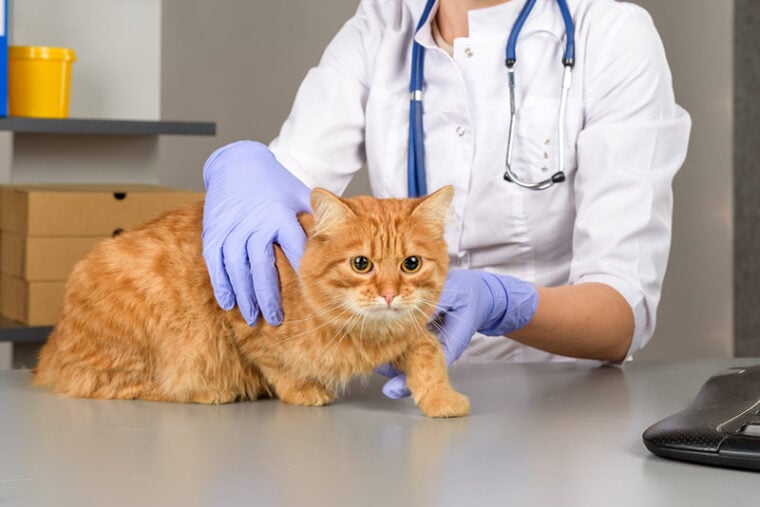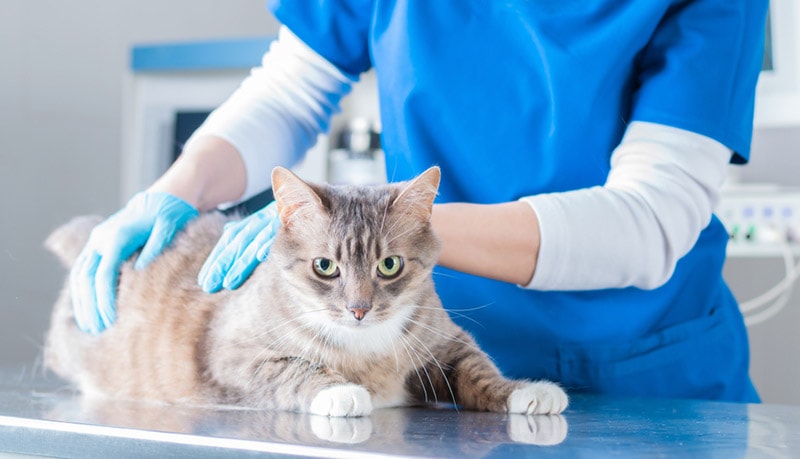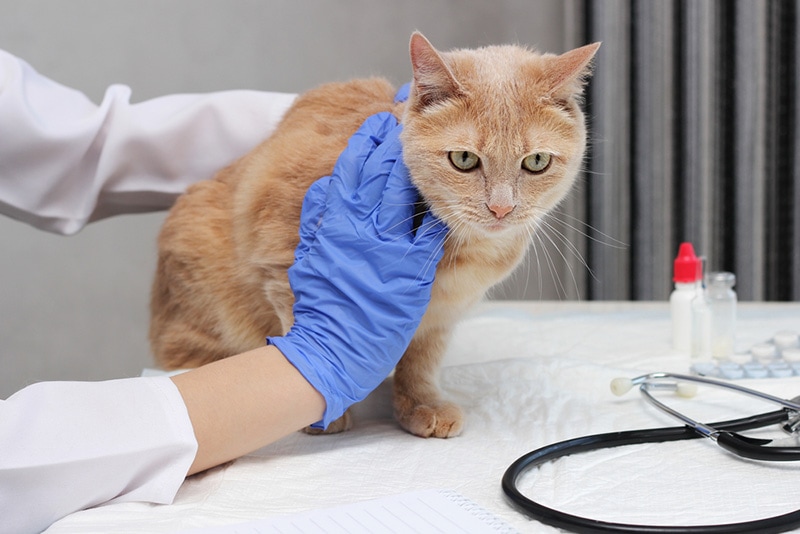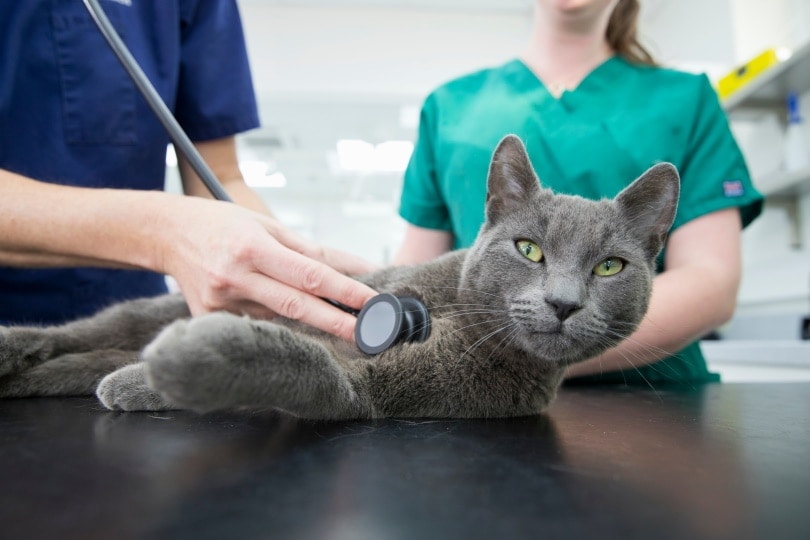
Seeing a cat have a seizure is a troubling experience for any cat owner. Seizures, also known as convulsions or fits, can present in various ways in cats. During a seizure, some cats drool or repetitively twitch their ears or eyelids while resting. Sometimes these episodes happen suddenly, and the cat quickly returns to normal. In more severe cases, a cat may bite its tongue, tremor violently, propel itself into the air, and lose consciousness.
If you witness your cat experiencing seizures of any kind, it is important to have your cat evaluated by your veterinarian to determine the diagnosis, cause, and if treatment is warranted.

What Is Feline Epilepsy?
Epilepsy is a chronic condition characterized by recurring episodes of seizure activity. The seizure itself is a sudden increase in the electrical activity of the brain, which results in a variety of visible activity in the body, including involuntary twitching, tremors, or convulsions. With epilepsy, seizure activity can occur in individual incidents, or they may occur in clusters. An epileptic cat’s seizures may be rare and random, while another epileptic cat’s seizures may occur with a regular pattern.
Some cats have seizures because there is a problem within their brains (e.g., a tumor or infection), while for others, a cause for the seizures is not detectable. Epilepsy of an unknown cause is called idiopathic epilepsy. While idiopathic epilepsy can occur in cats, it is not nearly as common of a diagnosis as it is in dogs. Instead, most cats have epilepsy because of a problem with their brain, in contrast to dogs, who more often have a systemic problem outside the brain that is causing their epilepsy.
Because most cases of feline epilepsy are caused by a disease within the brain, the diagnostic testing and treatment can be different than in dogs.

What Are the Signs of Feline Epilepsy and Seizures?
Seizure activity can vary greatly in severity, duration, and frequency. During generalized or grand mal seizures, cats can violently convulse, arch their backs, bite their tongues, vocalize, and lose consciousness. In these instances, a cat’s limbs can become very rigid or repetitively paddle.
The cat might also lose control of their bowels and bladder. Grand mal seizures can occur as solitary episodes or in clusters. The seizure episodes themselves can last around 1–2 minutes. A grand mal seizure lasting more than 5 minutes is a medical emergency called “status epilepticus”. If this happens, your cat should be seen by a veterinarian immediately.
Other seizures can be less intense and can end very quickly. In fact, some pet owners may not even recognize any issue with their cats. The most common type of seizure in cats is focal seizures which are sudden changes in electrical activity that occur in a specific area of the brain versus the entire brain, like during a generalized/grand mal seizure.
Since only one specific area of the brain is affected during a focal seizure, a cat may only show a limited range of seizure activity. Subtle signs of a focal seizure can include repetitive twitching of the ears or eyelids and flickering of the whiskers. More overt signs of a focal seizure can include biting at the air with their mouths (“fly-biting”), tail chasing, colliding with objects, or propelling themselves into the air.
What Are the Causes of Feline Epilepsy and Seizures?
Unlike dogs, most causes of epilepsy in cats are due to disease in the brain. Rarely, feline seizures may be caused by a toxin or metabolic disease (e.g., liver or kidney disease).
When the cause of epilepsy is inside the head, it is considered intracranial epilepsy. For primary intracranial epilepsy, there is no determined cause of epilepsy, so it is considered “idiopathic”. Cats with idiopathic epilepsy tend to experience their first seizure activity when they are young adults. There seems to be no evidence of a genetic predisposition for feline idiopathic epilepsy like there is in dogs.
For cases of secondary epilepsy, there is a structural problem within the brain, such as inflammation, infection, tumor, trauma, or congenital defect. Depending on the primary problem, secondary epilepsy can be accompanied by other symptoms, such as fever, lethargy, restlessness, or discoordination.
A common infectious cause of epilepsy in young or middle-aged cats is feline infectious peritonitis (FIP). This viral infection should remain high on the list of differential diagnoses in a young or middle-aged cat, especially if they experience other vague signs of illness before the onset of seizures (e.g., fever, poor appetite, coughing, vomiting, diarrhea).

How Do I Care for a Cat With Epilepsy?
For primary (idiopathic) epilepsy for which there is no known cause of the seizures, your veterinarian may prescribe an anti-seizure medication to be given to your cat long-term. In some cases, the seizure episodes are mild and infrequent enough that your cat won’t need to be given medication. It is very helpful to keep a log or diary of seizure activity that you can share with your cat’s veterinarian so they fully understand the patterns of your cat’s seizures.
One of the most important points to note when beginning treatment for your cat’s epilepsy is that the goal of the treatment is not to cure the condition, but instead, the aim is to control the seizures and reduce their frequency.
If medications are warranted, your veterinarian has a few treatment options, including phenobarbital, levetiracetam, zonisamide, gabapentin, and pregabalin. Cats handle phenobarbital better than dogs, who tend to experience side effects with their livers when on this medication.
It is important to note a few things when beginning anti-seizure medications prescribed by your veterinarian. Always follow the label closely, paying close attention to the dosage and timing of the medication. Be sure to always have enough supply of medication, so you don’t have any gaps in doses. Notify your veterinary clinic when your supply is running low so they have enough time to be sure they have it in stock before you completely run out. Any missed doses could result in a seizure.
Consult your veterinarian if you are interested in giving your cat any other supplements, as they may counteract your cat’s seizure medication.

Frequently Asked Questions (FAQs)
What should I do while a cat is having a seizure?
Even though seizures can be so scary to witness, they are not a medical emergency unless the cat is experiencing a generalized/grand mal seizure lasting longer than 5–10 minutes (status epilepticus). If you see your cat starting to have a seizure, keep calm and try not to touch your cat unless they are at risk of hurting themselves (e.g., falling off a high surface like a staircase or cat tree or near the edge of deep water). If you try to touch your cat during its seizure, you put yourself at risk of accidentally getting bitten or scratched and seriously injuring yourself.
Most seizure episodes last 1–2 minutes. While that sounds like a long time, again, it is rarely a medical emergency. However, if the seizure is not stopping and is lasting longer than 5–10 minutes, your cat is in status epilepticus and should be seen for emergency veterinary care right away. To transport your pet safely and quickly to the vet’s office, use a thick towel or blanket to pick up your cat and wrap them loosely for transit.
Your veterinarian will want to learn more about your cat’s recent seizure activity as well as its general health history (e.g., vaccine history, outdoor lifestyle, nutrition, and any other symptoms besides seizures).

What can be done to determine the cause of a cat’s seizures?
Since most cases of feline epilepsy are caused by a disease in the cat’s brain, it is important to perform diagnostic tests to investigate the underlying cause. A variety of tests are often done to reach the final diagnosis. At first, your veterinarian will likely recommend performing general blood and urine tests to investigate whether there are any causes of the seizures outside the brain.
In some cases, your veterinarian may also recommend radiographs and an abdominal ultrasound to further explore potential causes of seizures outside the brain.
In many cases, advanced imaging like magnetic resonance imaging (MRI) and computer-assisted tomography (CT) scans can be done to capture detailed images of the brain’s structure. These imaging techniques are especially important in diagnosing certain causes of epilepsy, like tumors.
What are the treatment options for a cat with epilepsy?
There are a variety of treatment options for feline epilepsy. If your cat is stable but is having regular seizures, your veterinarian may prescribe an anticonvulsant medication and any additional treatment for the underlying case. If your cat’s seizures are rare (less than once every 6–8 weeks), they may not actually need any medication.
In all cases, it is helpful to keep a diary of your cat’s seizure activity so you can consult your veterinarian if the seizures seem to become more frequent (whether they are already on medication).
Once your cat is prescribed medication for its epilepsy, it is important to follow your veterinarian’s specific instructions, as many of the anticonvulsant medications need to build up in the body to become and remain effective. Changing the dose or suddenly stopping the medication could cause your cat’s seizures to return or worsen.


Summary
While seizures in their cats can be a very scary experience for cat owners to experience, many cats with epilepsy can be managed with a proper diagnosis and treatment. If your cat is having regular seizures, it is important to track the details of the seizure activity and have your cat evaluated by a veterinarian to receive an accurate diagnosis and treatment recommendations.
Featured Image Credit: M. Arkhipov, Shutterstock






